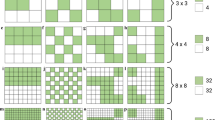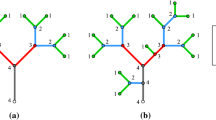Abstract
Landscapes are complex ecological systems that operate over broad spatiotemporal scales. Hierarchy theory conceptualizes such systems as composed of relatively isolated levels, each operating at a distinct time and space scale. This paper explores some basic properties of scaled systems with a view toward taking advantage of the scaled structure in predicting system dynamics. Three basic properties are explored:
(1) hierarchical structuring, (2) disequilibrium, and (3) metastability. These three properties lead to three conclusions about complex ecological systems. First, predictions about landscape dynamics can often be based on constraints that directly result from scaled structure. Biotic potential and environmental limits form a constraint envelope, analogous to a niche hypervolume, within which the landscape system must operate. Second, within the constraint envelope, thermodynamic and other limiting factors may produce attractors toward which individual landscapes will tend to move. Third, because of changes in biotic potential and environmental conditions, both the constraint envelope and the local attractors change through time. Changes in the constraint structure may involve critical thresholds that result in radical changes in the state of the system. An attempt is made to define measurements to predict whether a specific landscape is approaching a critical threshold.
Similar content being viewed by others
Literature cited
Allen, T.F.H. and Starr, T.B. 1982. Hierarchy: perspectives for ecological complexity. University of Chicago Press.
Andrews, J.F. 1968. A mathematical model for continuous cultivation of microorganisms utilizing inhibitory substrates. Biotechnol. Bioeng. 10: 707–723.
Bermudez, J. and Wagensberg, J. 1985. Microcalorimetric and thermodynamic studies of the effect of temperature on the anaerobic growth of Serratia marcescens in a minimal glucose-limited medium. J. Therm. Anal. 30: 1397–1402.
Bermudez, J. and Wagensberg, J. 1986. On entropy production in microbiological stationary states. J. Theor. Biol. 122: 347–358.
Bolin, B. 1970. The carbon cycle. Sci. Am. 223(3): 125–132.
Borighem, G. and Vereecken, J. 1981. Model of a chemostat utilising phenol as inhibitory substrate. Ecol. Modell. 2: 231–243.
Carpenter, S.R. and Kitchell, J.F. 1987. The temporal scale of variance in limnetic primary production. Am. Nat. 129: 417–433.
Chi, C.T., Howell, J.A. and Pawlowsky, U. 1974. The regions of multiple stable steady states of a biological reactor with wall growth, utilizing inhibitory substrates. Chem. Eng. Sci. 29: 207–211.
Crowley, T.J. and North, G.R. 1988. Abrupt climate change and extinction events in earth history. Science 240: 996–1002.
DeAngelis, D.L. and Waterhouse, J.C. 1987. Equilibrium and nonequilibrium concepts in ecological models. Ecol. Monogr. 57: 1–21.
Delcourt, H.R., Delcourt, P.A. and Webb, T. 1983. Dynamic plant ecology: the spectrum of vegetation change in space and time. Quat. Sci. Rev. 1: 153–175.
Edmondson, W.T. 1944. Ecological studies of sessile Rotatoria. Part 1. Factors limiting distribution. Ecol. Monogr. 14: 31–66.
Eldredge, N. 1985. Unfinished synthesis: biological hierarchies and modern evolutionary thought. Oxford University Press, New York.
Fisher, S.G. and Likens, G.E. 1973. Energy flow in Bear Creek, New Hampshire: an integrative approach to stream ecosystem metabolism. Ecol. Monogr. 43: 421–439.
Forman, R.T.T. and Godron, M. 1986. Landscape ecology. John Wiley and Sons, New York.
Forrest, W.W. and Walker, D.J. 1962. Thermodynamics of biological growth. Nature 196: 990–991.
Forrest, W.W. and Walker, D.J. 1964. Change in entropy during bacterial metabolism. Nature 201: 49–52.
Gaudy Jr., A.F., Lowe, W., Rozich, A. and Colvin, R. 1988. Practical methodology for predicting critical operating range of biological systems treating inhibitory substrates. J. Water Pollut. Control Fed. 60: 77–85.
Glansdorff, P. and Prigogine, I. 1971. Thermodynamic theory of structure, stability and fluctuations. Wiley Interscience, New York.
Golley, F.B. 1960. Energy dynamics of a food chain of an old-field community. Ecol. Monogr. 30: 187–206.
Haken, H. 1983. Synergetics: an introduction. 3rd ed. Springer-Verlag, Heidelberg.
Hutchinson, G.E. 1958. Concluding remarks. Cold Spring Harbor Symp. on Quant. Biol. 22: 415–427.
Hutchinson, G.E. 1965. The ecological theater and the evolutionary play. Yale University Press, New Haven, CT.
Hutchinson, G.E. 1970. The chemical ecology of three species of Myriophyllum (Angiospermae, Haloragaceae). Limnol. Oceanogr. 15: 1–5.
Jones, D.D. 1975. The application of catastrophe theory to ecological systems. RR-75–15. International Institute for Applied Systems Analysis, Laxenburg, Austria.
Lindemann, R.L. 1942. The trophic-dynamic aspect of ecology. Ecology 23: 399–418.
McGinnis, J.T., Golley, F.B., Clements, R.G., Child, G.I. and Duever, M.J. 1969. Elemental and hydrologic budgets of the Panamanian tropical moist forest. Bioscience 19: 697–700.
Menhinick, E.F. 1967. Structure, stability, and energy flow in plants and arthropods in a Sericea lespedeza stand. Ecol. Monogr. 37: 255–272.
Naveh, Z. and Lieberman, A.S. 1984. Landscape ecology: theory and application. Springer-Verlag, New York.
Odum, H.T. 1957. Trophic structure and productivity of Silver Springs, Florida. Ecol. Monogr. 27: 55–112.
O'Neill, R.V. 1988. Hierarchy theory and global change. In Scales and Global Change, pp. 29–45T. Edited by R. Rosswall, G. Woodmansee and P. Risser. John Wiley and Sons, New York.
O'Neill, R.V. (in press). Perspectives in hierarchy theory. In Perspectives in Theoretical Ecology. Edited by R.M. May and J. Roughgarten. Princeton University Press, Princeton, NJ.
O'Neill, R.V. and DeAngelis, D.L. 1981. Comparative productivity and biomass relations of forest ecosystems. In Dynamic Properties of Forest Ecosystems, pp. 411–449. Edited by D.E. Reichle. Cambridge University Press, Cambridge, UK.
O'Neill, R.V., DeAngelis, D.L., Allen, T.F.H. and Waide, J.B. 1986. A hierarchical concept of ecosystems. Monographs in Population Biology 23. Princeton University Press, Princeton, NJ.
Park, R.A., O'Neill, R.V., Bloomfield, J.A., Shugart, H.H., Booth, R.S., Goldstein, R.A., Mankin, J.B., Koonce, J.F., Scavia, D., Adams, M.S., Clesceri, L.S., Colon, E.M., Dettmann, E.H., Hoopes, J.A., Huff, D.D., Katz, S., Kitchell, J.F., Kohberger, R.C., LaRow, E.J., McNaught, D.C., Peterson, J.L., Titus, J.E., Weiler, P.R., Wilkinson, J.W., Zahorcak, C.S. 1975. A generalized model for simulating lake ecosystems. Simulation 23: 33–50.
Pawlowsky, U., Howell, J.A. and Chi, C.T. 1973. Mixed culture biooxidation of phenol. III. Existence of multiple steady states in continuous culture with wall growth. Biotechnol. Bioeng. 15: 905–916.
Pearson, O.P. 1964. Carnivore-mouse predation: an example of its intensity and bioenergetics. J. of Mammal. 45: 177–188.
Pielou, E.C. 1972. Niche width and niche overlap: a method for measuring them. Ecology 53: 687–692.
Pielou, E.C. 1977. Mathematical ecology. John Wiley and Sons, New York.
Plant, R.E. and Kim, M. 1975. On the mechanism underlying bursting in the Aplysia abdominal ganglion R12 cell. Math. Biosci. 26: 357–375.
Porter, W.P. and Gates, D.M. 1969. Thermodynamic equilibria of animals with environment. Ecol. Monogr. 39: 227–244.
Prigogine, I. 1967. Introduction to thermodynamics of irreversible processes, 3rd ed. Wiley Interscience, New York. [English translation of work first published in French in 1947.]
Reichle, D.E., O'Neill, R.V. and Olson, J.S. 1973. Modeling forest ecosystems. EDFB-IBP-73–7. Oak Ridge National Laboratory, Oak Ridge, TN.
Rozich, A.F. and Gaudy Jr., A.F. 1985. Response of phenolacclimated activated sludge to quantitative shock loading. J. Water Pollut. Control Fed. 57: 795–804.
Salthe, S.N. 1985. Evolving hierarchical systems: their structure and representation. Columbia University Press, New York.
Satchell, J.E. 1971. Feasibility study of an energy budget for Meathop Woods. In Proceedings of the Symposium on Productivity of the Forest Ecosystems of the World. UNESCO, Paris.
Schaarschmidt, B., Zotin, A.I., Brettel, R. and Lamprecht, I. 1975. Experimental investigation of the bound dissipation: change of the u-function during the growth. Arch. Microbiol. 105: 13–16.
Schaarschmidt, B., Zotin, A.I. and Lamprecht, I. 1977. Quantitative relation between heat production and weight during growth of microbial cultures. In Applications of Calorimetry in Life Sciences, pp. 139–148. Edited by I. Lamprecht and B. Schaarschmidt (eds.), Walter de Gruyter, Berlin.
Schindler, D.W. 1977. Evolution of phosphorus limitation in lakes. Science 195: 260–262.
Schindler, D.W. 1978. Factors regulating phytoplankton production in the world's freshwaters. Limnol. Oceanogr. 23: 478–486.
Schindler, J.E., Waide, J.B., Waldron, M.C. Hains, J.J., Schreiner, S.P., Freedman, M.L., Benz, S.L., Pettigrew, D.R., Schissel, L.A. and Clark, P.J. 1980. A microcosm approach to the study of biogeochemical systems. 1. Theoretical rationale. In Ecological Research, pp. 192–203. Edited by J.P. Giesy Jr. Symposium Series 52, CONF-781101, US Department of Energy, Washington, DC.
Schoner, G. and Kelso, J.A.S. 1988. Dynamic pattern generation in behavioral and neutral systems. Science 239: 1513–1520.
Steele, J.H., ed. 1978. Spatial pattern in plankton communities. Plenum Press, New York.
Stent, G.S. 1978. Paradoxes of progress. W.H. Freeman, San Francisco.
Stoward, P.J. 1962. Thermodynamics of biological growth. Nature 194: 977–978.
Teal, J.M. 1957. Community metabolism in a temperate cold spring. Ecol. Monogr. 27: 283–302.
Tikhonov, A.N. 1950. On systems of differential equations containing parameters. Mat. Sb. 27: 147–156 [in Russian].
Tilly, L.J. 1968. The structure and dynamics of Cone Spring. Ecol. Monogr. 38: 169–197.
Urban, D.L. and O'Neill, R.V. (in press). Mechanisms of avian demography: sensitivity, uncertainty, and scaling implications. Ecology.
Vollenweider, R.A. 1975. Input-output models with special reference to the phosphorus loading concept in limnology. Schweiz. Z. Hydrol. 37: 53–84.
Vollenweider, R.A. 1976. Advances in defining critical loading levels for phosphorus in lake eutrophication. Mem. Ist. Ital. Idrobiol. 33: 53–83.
Weaver, W. 1948. Science and complexity. Am. Sci. 36: 537–544.
Weinberg, G.M. 1975. An introduction to general systems thinking. John Wiley and Sons, New York.
Weinberg, G.M. and Weinberg, D. 1979. On the design of stable systems. John Wiley and Sons, New York.
Whittaker, R.H. 1961. Experiments with radiophosphorus tracer in aquarium microcosms. Ecol. Monogr. 31: 157–188.
Wiens, J.A. (in press). Spatial scaling in ecology. Functional Ecology.
Witkamp, M. and Frank, M.L. 1969. Cesium-137 kinetics in terrestrial microcosms. In Proceedings of the Second National Symposium on Radioecology. pp. 635–643. Edited by D.J. Nelson and F.C. Evans. CONF-670503. United States Atomic Energy Commission, Washington, DC.
Worden, R.M. and Donaldson, T.L. 1987. Dynamics of a biological fixed film for phenol degradation in a fluidized-bed bioreactor. Biotechnol. Bioeng. 30: 398–412.
Yano, T. and Koga, S. 1969. Dynamic behavior of the chemostat subject to substrate inhibition. Biotechnol. Bioeng. 11: 139–153.
Zotin, A.I., Zotina, R.S. and Konoplev, V.A. 1978. Theoretical basis for a qualitative phenomenological theory of development. In Thermodynamics of biological processes, pp. 85–98. Edited by I. Lamprecht and A.I. Zotin. Thermodynamics of Biological Processes. Walter deGruyter, Berlin.
Author information
Authors and Affiliations
Additional information
Research supported in part by the Ecological Research Division Office of Health and Environmental Research, US Department of Energy under contract No. DE-AC05-840R21400 to Martin Marietta Energy Systems Inc., and in part by the Ecosystem Studies Program, National Science Foundation, under Interagency Agreement No. NSF BSR 8315185 to the Department of Energy. Publication No. 3381, Environmental Sciences Division, Oak Ridge National Laboratory.
Dr. Johnson's participation was supported in part by an appointment to the Postgraduate Research Training program under contract DE-AC05-76OR00033 between the U.S. Department of Energy and Oak Ridge Associated Universities, Oak Ridge, TN 37831.
Rights and permissions
About this article
Cite this article
O'Neill, R.V., Johnson, A.R. & King, A.W. A hierarchical framework for the analysis of scale. Landscape Ecol 3, 193–205 (1989). https://doi.org/10.1007/BF00131538
Issue Date:
DOI: https://doi.org/10.1007/BF00131538




